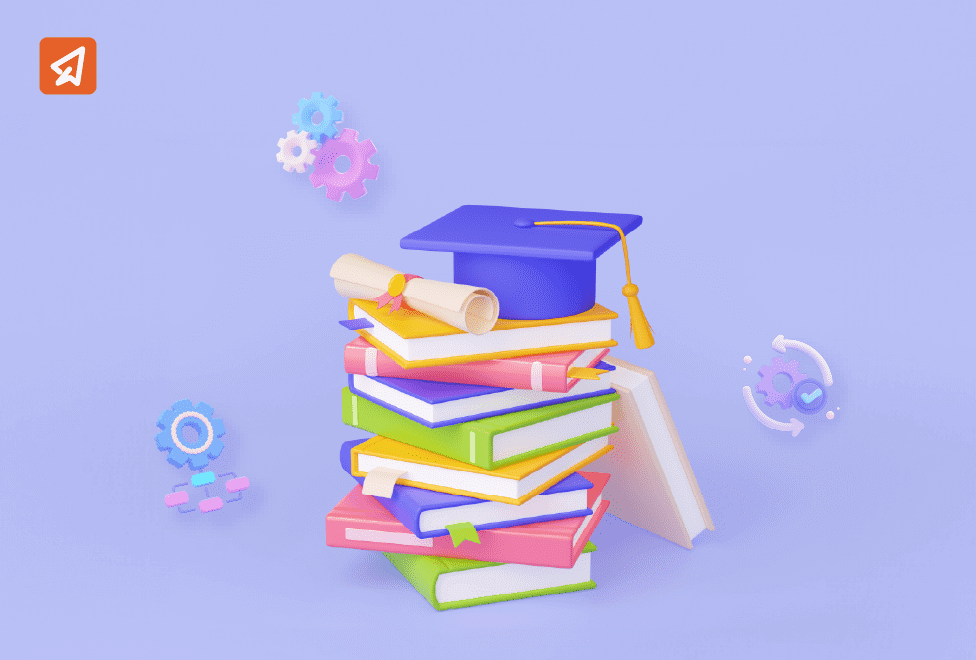A Teacher’s Guide to Spiral Curriculum: Benefits, Challenges, and Best Practices

Think about a time when you taught a concept, and some students understood it right away while others needed more time. Then, a few months later, when you brought up the same topic again, even those who seemed confident before had trouble remembering it.
This is completely normal because learning does not happen all at once. In this blog, we will take a closer look at what a spiral curriculum is and how it works, so without waiting further, let’s get started.
What is a Spiral Curriculum?
Students need to come across ideas more than once, each time understanding them a little better. That is exactly what a spiral curriculum does. Instead of covering a topic once and moving on, it brings concepts back at different stages, helping students strengthen their understanding over time.
What are the Key Principles of The Spiral Curriculum?
The spiral curriculum is based on three main principles that guide how students learn and build their understanding over time. Here’s how they work:
-
Learning in Cycles
Students don’t just learn something once and forget about it. They come back to the same topics at different stages of their schooling. This repetition helps them remember what they learned and see how it connects to new ideas. It also gives them more chances to practice and apply what they know, making learning more solid.
-
Deeper Understanding with Each Step
When a topic is reintroduced, it isn’t taught in the same way as before. Instead, students explore it in more detail and deal with more complex ideas. What starts as a simple introduction in the early years becomes a more detailed discussion later. This way, students don’t feel overwhelmed by difficult concepts because they have already built a basic understanding.
-
Using What They Already Know
Learning is easier when students can connect new information to what they have already learned. Instead of starting from scratch, they build on what they know. This approach makes learning feel natural and helps students see how subjects are connected over time.
How to Design a Spiral Curriculum That Works?
-
Identify the Most Important Concepts and Skills
Before planning lessons, it is important to be clear about what students should know and be able to do by the end of the course. These concepts and skills should align with academic standards and real-world applications.
It also helps to check what students already understand and what interests them. When lessons are planned with these factors in mind, students find learning more engaging and relevant. Having a clear goal also helps them stay motivated and see the purpose of their learning.
-
Plan Content and Activities in a Logical Order
Once the learning goals are set, the next step is to arrange lessons in a way that helps students move from basic to more advanced understanding. Topics should be introduced in a simple way and then revisited with added depth.
For example, younger students might start with basic addition and subtraction using fingers or number lines. Later, they move on to solving problems in their heads and working with bigger numbers.
Using curriculum maps and outlines can help plan lessons in a way that connects topics across different subjects. Well-structured lessons make it easier for students to understand and remember what they learn.
-
Creating a Student-Focused Classroom
A good curriculum keeps students at the center of learning. It is important to give them the right support and guidance so they can connect new ideas with what they already know.
Teachers can:
- Use discussions and Q&A sessions to refresh past lessons.
- Give real-time feedback to clear up misunderstandings.
- Encourage peer collaboration so students learn from each other.
- Use digital tools like learning management systems for personalised assessments.
When students see how new knowledge fits with what they have already learned, they become more confident and independent in their learning journey.
-
Checking How Well Students Have Learned
The last step is to assess whether students have truly understood and retained the concepts. Different types of assessments can help track progress, such as:
- Short quizzes and discussions to check understanding during lessons.
- Tests and projects to measure overall learning.
- Real-life tasks to see how students apply what they have learned.
Assessment results also help teachers adjust lessons to better match student needs. Making small changes along the way ensures that students continue to improve and gain a strong understanding of the subject.
Benefits of a Spiral Curriculum
Using a spiral curriculum in teaching brings several benefits, such as:
-
Connecting Different Areas of Learning
A major advantage of a spiral curriculum is that it helps students bring together ideas from different topics. Instead of just memorising facts, they get opportunities to use what they have already learned and apply it in different situations. For example, a math concept introduced in one grade may be revisited later in a science lesson, helping students see how subjects connect. This way, learning feels more natural, and students gain confidence in using their knowledge across different areas.
-
Teaching in a Way That Makes Sense
The order in which students learn topics is important. A spiral curriculum introduces simple ideas first and builds on them gradually. This way, students are not overwhelmed by complex concepts too soon. For example, in math, they might start with basic number operations before moving on to fractions and algebra. Because lessons build on each other, students can see the connections between what they have already learned and what they are learning next. This helps them feel more confident as they move through different topics.
-
Revisiting Topics at the Right Time
Sometimes, students are introduced to a topic but might not fully understand it the first time. As they grow, their thinking skills improve, making it easier for them to grasp certain ideas. A spiral curriculum allows teachers to go back to these topics when students are more ready for them. Instead of feeling stuck with something they do not understand, students get another chance to learn it when it makes more sense to them.
-
Building on What Students Already Know
Every student comes to class with some background knowledge. A spiral curriculum makes use of this by connecting new lessons to what students have already learned. Before introducing a new topic, teachers can check what students remember and use that as a starting point. This way, students do not feel like they are learning something completely new all the time. Instead, they see how their previous knowledge helps them understand new ideas.
-
Encouraging Collaboration Among Teachers
For a spiral curriculum to work well, teachers need to collaborate and plan lessons that connect across different grades and subjects. When educators work as a team, they ensure that students are getting a smooth and consistent learning experience. This kind of coordination helps students see how everything they learn is part of a bigger picture, making their education more meaningful.
Disadvantages of a Spiral Curriculum
While a spiral curriculum has its advantages, it may not always be the best fit for every subject or teaching environment. Here are some challenges teachers might face when using this approach.
-
Some Subjects Do Not Fit Well
A spiral curriculum works better for subjects like math and science, where ideas build on each other in a structured way. In subjects like art or literature, learning is more open-ended, so this approach may not always fit naturally. While some skills, like improving drawing techniques or writing style, develop over time, not all topics in these subjects follow a clear step-by-step process. This can make it difficult to apply a spiral structure to every lesson.
-
Too Much Content to Cover
There is always a lot to teach in a limited time. A spiral curriculum revisits topics often, but if there is too much to cover, lessons may feel rushed. Sometimes, topics are introduced briefly with the idea that they will come up again later. This can leave students with a surface-level understanding before moving on. In some cases, focusing on one topic until students fully understand it might work better.
-
Not Suitable for Short Courses
A spiral curriculum works best when there is enough time to return to topics over the long term. In short courses, this is not always possible. If a subject is taught for only a few weeks or months, there is little room to keep revisiting the same content. In these cases, it may be better to teach content in a more direct way instead of spreading it out.
-
More Time Spent Re-teaching Than Moving Forward
One common issue with a spiral curriculum is that teachers often have to reteach concepts instead of simply building on them. Students may forget what they learned, struggle with earlier lessons, or pick up misunderstandings along the way. Instead of moving forward smoothly, teachers may spend extra time going over past material to fill in the gaps.
Spiral Curriculum Examples
Let’s take a closer look at some examples that show how a spiral curriculum works in real life:
-
Mathematics
Math builds on itself naturally, making it an ideal subject for a spiral approach. Take multiplication as an example.
- In the early years, students start by learning basic multiplication facts like 2 × 3 = 6.
- As they move forward, they practice multiplying two-digit numbers, such as 24 × 12.
- Later, they apply multiplication to decimals and fractions, like 2.5 × 3.4 or ⅔ × 4.
- In higher grades, they use multiplication in algebra, such as solving equations or working with exponents.
Since multiplication is introduced early and revisited often, students don’t just memorise—it becomes a skill they can use in different ways.
-
Literacy
Reading and writing skills grow stronger when students revisit them regularly. Writing paragraphs is a good example.
- Young learners begin by forming simple sentences.
- As they progress, they write short paragraphs with a clear topic and supporting details.
- Later, they learn how to structure essays with introductions, body paragraphs, and conclusions.
- By high school, they apply these skills to research papers, persuasive writing, and literary analysis.
Each time they return to writing, they refine their ability to organise ideas, express thoughts clearly, and use better vocabulary.
-
Language Learning
A new language isn’t learned all at once. It takes time and practice.
- At first, students start with simple words and greetings.
- Next, they move on to forming basic sentences and asking common questions.
- Later, they learn grammar rules, verb tenses, and more complex sentence structures.
- Over time, they work on fluency, understanding native speakers, and writing longer pieces like essays or reports.
Since each stage builds on the previous one, students develop confidence in using the language naturally.
-
Science
Science topics become clearer when students return to them at different levels of complexity. Take the concept of energy.
- In early grades, students learn about basic forms of energy, like heat, light, and sound.
- Later, they explore how energy moves and transforms, such as in food chains or simple circuits.
- As they advance, they study kinetic and potential energy in more detail.
- In high school, they apply these ideas to topics like thermodynamics and renewable energy.
Since the topic keeps coming back, students don’t just memorise facts—they start understanding how energy works in the real world.
-
Social Studies
History, geography, and civics make more sense when students revisit topics and connect them to new ideas. Let’s take the government as an example.
- At a young age, students learn about rules, responsibilities, and community leaders.
- Later, they study different types of governments and how they function.
- In middle school, they explore historical events that shaped modern governments.
- By high school, they analyse political systems, global issues, and civic responsibilities.
Since they build on what they already know, students develop a deeper understanding of how societies work and change over time.
How Extramarks Supports a Spiral Curriculum?
Helping students remember what they have learned is just as important as teaching new topics. If past lessons fade, advanced concepts become harder to understand. The spiral curriculum helps by revisiting previous topics while slowly introducing new ideas. Extramarks makes this process smoother by organising lessons in a way that keeps students engaged and helps them build on what they already know.
-
Helping Students Revisit Concepts
Students understand topics better when they go over them more than once. Extramarks makes this easier by offering lessons in different formats like videos, quizzes, and practice exercises. With recorded lectures and interactive activities, students can go back to earlier lessons whenever they need a refresher. This helps them remember concepts for a longer time.
-
Gradually Increasing Difficulty
Learning should happen step by step. Extramarks helps students move from basic to advanced topics by slowly increasing the level of difficulty. Its assessment tools show where students need extra practice so they can strengthen their foundation before moving ahead. The platform’s test modules also introduce harder questions at the right time, making sure students are ready for new challenges.
-
Connecting Old and New Learning
Students understand better when they see how topics are connected. Extramarks helps them relate new lessons to what they already know. With curriculum-based resources and a focus on understanding concepts, the platform makes learning more meaningful and easy to follow.
Make your classroom more engaging by integrating Extramarks Smart Class Plus!
It features game-based learning, helping students concentrate better on lessons and understand concepts with ease. To explore its benefits.
Try Smart Class PlusReviewed by

Prachi Singh | VP - Academics
Prachi Singh is a highly accomplished educationist with over 16 years of experience in the EdTech industry. Currently, she plays a pivotal role at Extramarks, leading content strategy and curriculum development initiatives that shape the future of education...read more.









